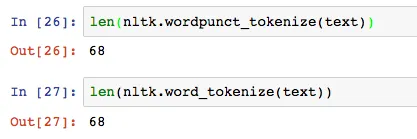1个回答
36
wordpunct_tokenize 是基于简单正则表达式的分词方法。其定义如下:
wordpunct_tokenize = WordPunctTokenizer().tokenize
您可以在此处找到WordPunctTokenizer。基本上,它使用正则表达式
\w+|[^\w\s]+来分割输入内容。另一方面,
word_tokenize基于TreebankWordTokenizer,请参见文档此处。它基本上像Penn Treebank一样对文本进行标记化。这里有一个愚蠢的例子,应该说明两者的区别。sent = "I'm a dog and it's great! You're cool and Sandy's book is big. Don't tell her, you'll regret it! 'Hey', she'll say!"
>>> word_tokenize(sent)
['I', "'m", 'a', 'dog', 'and', 'it', "'s", 'great', '!', 'You', "'re",
'cool', 'and', 'Sandy', "'s", 'book', 'is', 'big', '.', 'Do', "n't", 'tell',
'her', ',', 'you', "'ll", 'regret', 'it', '!', "'Hey", "'", ',', 'she', "'ll", 'say', '!']
>>> wordpunct_tokenize(sent)
['I', "'", 'm', 'a', 'dog', 'and', 'it', "'", 's', 'great', '!', 'You', "'",
're', 'cool', 'and', 'Sandy', "'", 's', 'book', 'is', 'big', '.', 'Don',
"'", 't', 'tell', 'her', ',', 'you', "'", 'll', 'regret', 'it', '!', "'",
'Hey', "',", 'she', "'", 'll', 'say', '!']
我们可以看到,
wordpunct_tokenize 函数会在所有特殊符号处进行分割,并将它们作为独立的单元处理。而 word_tokenize 则会保留像 're 这样的内容。但是它似乎并不太智能,因为我们可以看到它未能将初始单引号与 'Hey' 分开。有趣的是,如果我们将句子写成这样(使用单引号作为字符串定界符,双引号包围 "Hey"):
sent = 'I\'m a dog and it\'s great! You\'re cool and Sandy\'s book is big. Don\'t tell her, you\'ll regret it! "Hey", she\'ll say!'
我们获得
>>> word_tokenize(sent)
['I', "'m", 'a', 'dog', 'and', 'it', "'s", 'great', '!', 'You', "'re",
'cool', 'and', 'Sandy', "'s", 'book', 'is', 'big', '.', 'Do', "n't",
'tell', 'her', ',', 'you', "'ll", 'regret', 'it', '!', '``', 'Hey', "''",
',', 'she', "'ll", 'say', '!']
所以,word_tokenize 会分离双引号,但它也将它们转换为 `` 和 ''。而 wordpunct_tokenize 则不会这样做:
>>> wordpunct_tokenize(sent)
['I', "'", 'm', 'a', 'dog', 'and', 'it', "'", 's', 'great', '!', 'You', "'",
're', 'cool', 'and', 'Sandy', "'", 's', 'book', 'is', 'big', '.', 'Don',
"'", 't', 'tell', 'her', ',', 'you', "'", 'll', 'regret', 'it', '!', '"',
'Hey', '",', 'she', "'", 'll', 'say', '!']
- xdurch0
1
5谢谢,这很有帮助。所以总结一下,为了进行自然语言处理的清洗,您应始终选择使用word_tokenize,因为您不想单独处理标点符号。 - Rahib
网页内容由stack overflow 提供, 点击上面的可以查看英文原文,
原文链接
原文链接
- 相关问题
- 3 NLTK: word_tokenize 更改引号
- 5 NLTK的words与word_tokenize对比
- 4 NLTK在法语文本上的word_tokenize功能无法正常工作。
- 33 NLTK与斯坦福NLP的比较
- 6 滥用nltk的word_tokenize(sent)的后果
- 17 Python中的re.split()与nltk中的word_tokenize和sent_tokenize有什么区别?
- 4 Apache Open NLP与NLTK比较
- 11 从nltk word_tokenize获取原始文本的索引
- 3 如何使用NLTK中的word_tokenize忽略单词之间的标点符号?
- 4 使用NLTK的word_tokenize时出现错误
